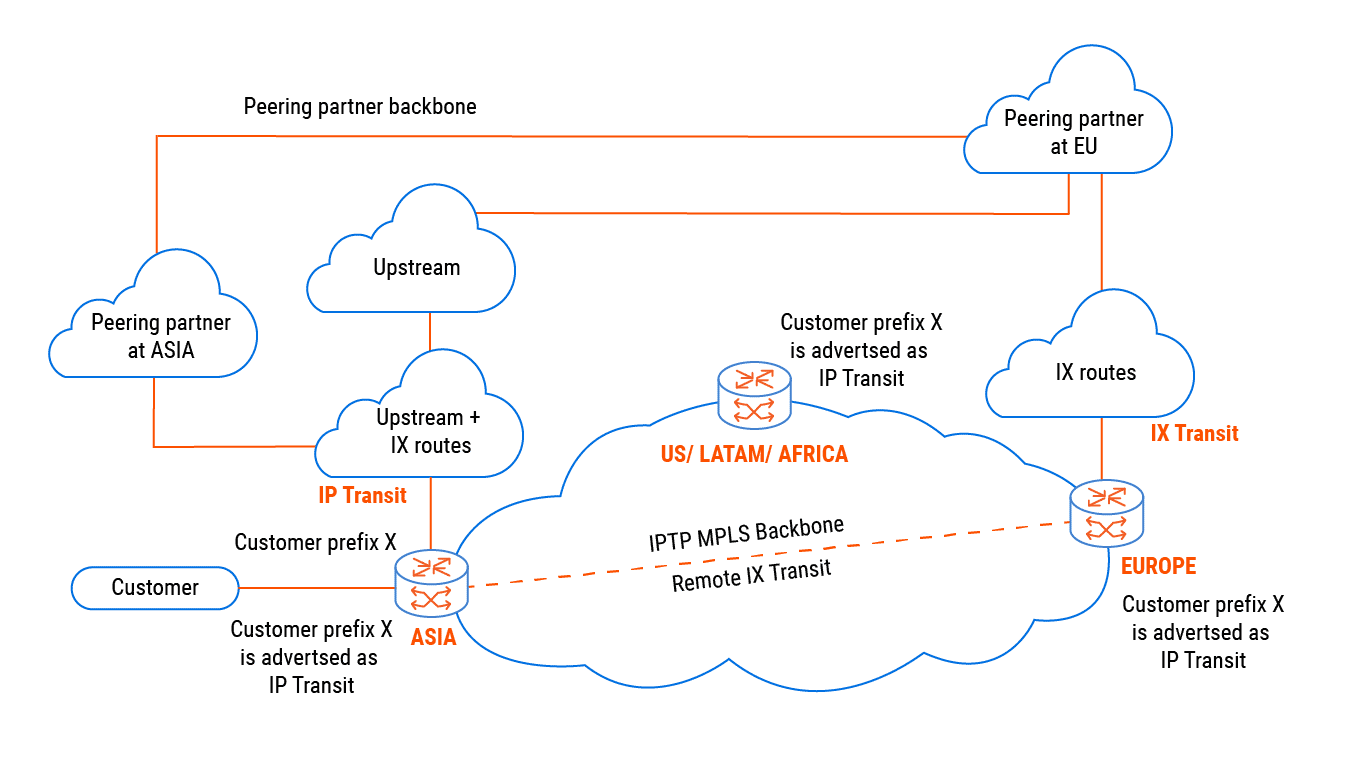Remote IX Transit is an interconnection service type when a customer establishes a direct BGP session with IPTP Networks’ router in other regions, rather than an interconnection location, for a partial BGP table.
By connecting to remote IPTP routers, the customer gains access to regional routes received from IXes, Private Peers, customers of IPTP Networks in those locations and customers’ prefixes also advertised to those parties.
HOW REMOTE IX TRANSIT WORKS
Due to the nature of regional routing, to get a real advantage of presenting at any market, we need to establish a remote connection to it. Technically speaking, Remote IX Transit is a combination of L2 MPLS and IX Transit from a specific distant region. Remote IX Transit provides the benefits of remote presence in a smart manner. However, to avoid loops via Remote IX Transit, it shall be used in conjunction with locally connected IP Transit at the interconnection point or customer market.
Without a local IX Transit BGP session, when learning new prefixes of regional ISPs via Remote IX Transit, your traffic will loop on the remote side. This is because the BGP path via remote session is shorter, which results in increasing latency and worsening Internet performance. In order to avoid potential negative impact, when acquiring remote regional-specific routes, you must ensure that the established robust connections are linked to both distant regions and data centers within the same city/country or nearby areas.

Similar to IX Transit, Remote IX Transit provides the same number of prefixes (around 400,000), and its rich BGP community set for prefix filtering and announces management allows network customization. In this scenario, a BGP session is established with a remote router through an L2 MPLS link. This process enables the acquisition of specific regional routes and enhances extensive traffic engineering on a global level.
REMOTE IX TRANSIT AND IP TRANSIT – BENEFITS
Combining Remote IX Transit and IP Transit provides the solution to your requirement for streamlined, rapid, and effortless connectivity:
- Optimal performance: Harness IPTP Networks’ ultra-low latency Global backbone to efficiently route traffic between Remote location and customers across different regions.
- Access to More Networks: Remote IX Transit provides a great opportunity to reach more Peering community members, enhancing customers’ ability to achieve a more extensive global reach.
- Traffic engineering: Customers can employ BGP attributes to manage a specific route within both services. When one path has a problem, they can change the path to fix the issue. Ingress and Outgress BGP Communities are supported.
- Cost Savings: Unlike Remote IX, which necessitates the establishment of its own access, Remote IX Transit service provides a significantly more cost-effective solution for connecting to remote IX locations.
- Redundancy and Resilience: Utilizing both services empower you to exercise greater control over your network’s routing, enabling optimization of the pathway traversed by your internet traffic. In the event of a specific IX experiencing downtime, Remote IX Transit traffic continues to flow seamlessly through the nearest IX within the same region, ensuring uninterrupted connectivity.
Discover IPTP Networks’ Public Peering Exchange Points at IX Transit.

